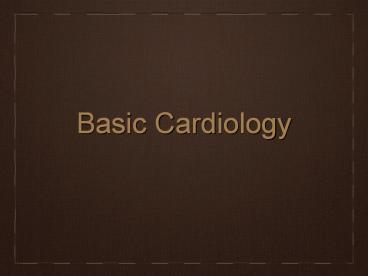Basic Cardiology - PowerPoint PPT Presentation
Title:
Basic Cardiology
Description:
Basic Cardiology The Heart Pericardium Epicardium Myocardium atrial muscle ventricular muscle conductive tissue Endocardium The Heart Myocardium branch intercalated ... – PowerPoint PPT presentation
Number of Views:2618
Avg rating:3.0/5.0
Title: Basic Cardiology
1
Basic Cardiology
2
(No Transcript)
3
(No Transcript)
4
The Heart
- Pericardium
- Epicardium
- Myocardium
- atrial muscle
- ventricular muscle
- conductive tissue
- Endocardium
5
The Heart
6
Myocardium
- branch
- intercalated disks with gap junctions
7
Intercalated Disc
8
Electrical Stimulation of the Heart
9
Sinoatrial (SA) Node
- Right atrium
- Inherent rhythm 80-100 bpm)
- Usually sets the heart rate (sinus rhythm)
10
Internodal Interarterial Pathways
- Internodal
- Anterior
- Middle (Wenckebach branch)
- Posterior
- Interatrial
- Anterior Interarterial band or Bachmanns bundle
11
Atrioventricular (AV) Junction
- AV Node
- Located at the base of the right atria near the
interventricular septum - Smaller cells, fewer gap junctions, slower
- Maximal rate is 230 per minute also maximal
ventricular rate
12
AV Junction
- AV Bundle or Bundle of His
- Only cellular connection between atria and
ventricles - Together with AV node make up the AV junctional
tissue - Intrinsic heart rate of 40-60 bpm
- If SA node fails, AV junctional tissue can
control heart rate - Slows down the cardiac impulse
13
Bundle Branches
- Right and left branches
- Two left branches (sometimes three)
- Left anterior fascicle or left anterior bundle
branch thinner, carries impulses to septum, left
anterior wall, and anterior papillary muscle - Left posterior fascicle or l. post. bundle
branch thicker, carries impulses to posterior,
inferior, left ventricular free wall and
posterior papillary m. with dual blood supply,
less likely to become ischemic, - Both left and right BB travel down towards the
apex of the heart where they fan out into
Purkinje fibers
14
Purkinje Fibers
- Pass through the ventricular myocardium
- Contraction starts at the apex
- Fast rate of action potential generation,
numerous sodium ion channels and mitochondria and
fewer myofibrils
15
(No Transcript)
16
(No Transcript)
17
Electrical Stimulation of the Heart
- Video
18
If you understand the normal physiologic
stimulation of the heart, you have the basis for
understanding the abnormalities of heart rhythm
and conduction the produce distinctive ECG
patterns. p. 5
19
Electrocardiogram
SA node
AV node
Atrial depolarization Ventricle
depolarization Ventricle repolarization
Bundle branches
Purkinje fibers
20
Electrocardiogram
21
Rhythms
- Normal conduction
- Sinus Rhythm
- Abnormal conduction
- Junctional rhythm
- e.g. escape pacemaker
- Ventricular rhythm
22
Cardiac Conductivity
- SA node - slow
- Internodal pathways - fast
- AV node - slow
- Purkinje fibers - faster
23
Cardiac Automaticity
- Automaticity
- SA node - primary pacemaker
- Other sites e.g. AV junction
- Certain conditions increase the automaticity of
ectopic pacemakers - Ectopic outside of the sinus node pacemaker
(non-sinus)
24
Abnormalities
- AV heart block blockage of stimuli through AV
junction - Bundle Branch Block disease of bundle branches
- ST segment changes damage to ventricular muscle
25
Coronary Arteries
26
Coronary Arteries
- The Left Main (LM)
- Left Anterior Descending (LAD)
- Left Circumflex (LCX).
- The Right Coronary Artery (RCA)
- The RCA on the posterior part of the heart is
often called the Posterior Descending Artery
(PDA), in most cases it originate from the RCA
but in some cases it comes from LCX.
27
Coronary Artery Perfusion
LAD Supply the anterior septum, the anterior wall, and in most cases apex.9 o'clock to 1 o'clock.
LCX Supply the lateral wall 2 o'clock to 4 o'clock
RCA Supply the posterior lateral segments, the inferior segments, and the posterior septum. 5 o'clock to 8 o'clock
28
Class Organization
- Resting 12 lead ECG
- Understanding normal 12 lead ECG and conditions
that cause abnormal depolarization and
repolarization - Recognizing abnormal rhythms and AV conduction
disturbances - Associating the ECG arrhythmia with its pathology
- Exercise ECG
- Recognizing abnormal rhythms and AV conduction
disturbances - Associating the ECG arrhythmia with its pathology































